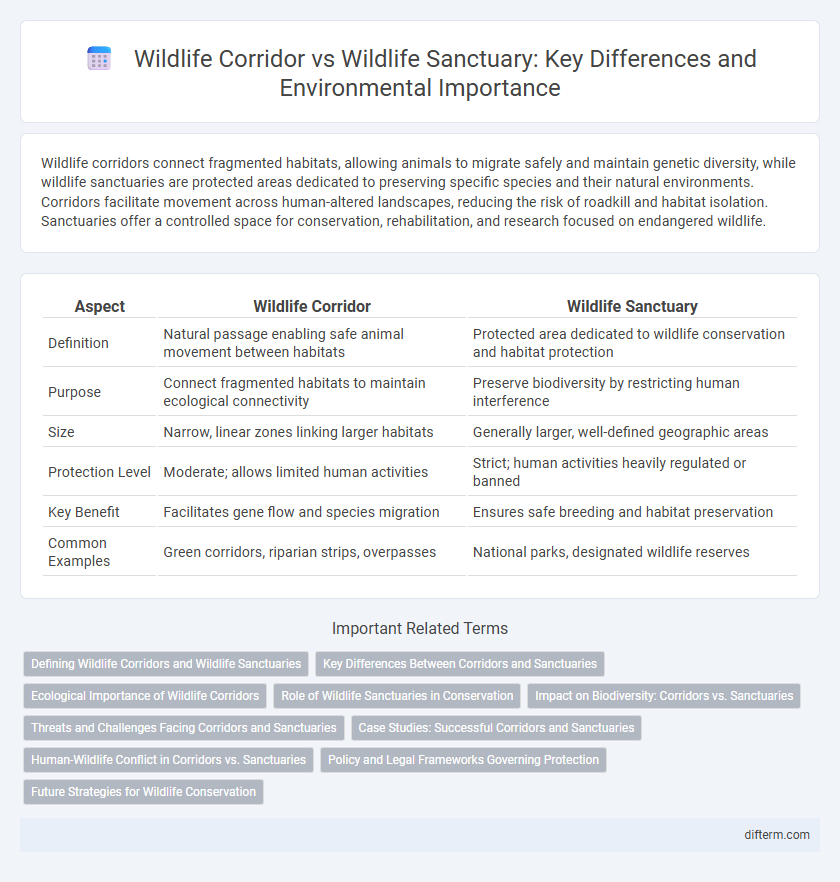Wildlife corridors connect fragmented habitats, allowing animals to migrate safely and maintain genetic diversity, while wildlife sanctuaries are protected areas dedicated to preserving specific species and their natural environments. Corridors facilitate movement across human-altered landscapes, reducing the risk of roadkill and habitat isolation. Sanctuaries offer a controlled space for conservation, rehabilitation, and research focused on endangered wildlife.
Table of Comparison
| Aspect | Wildlife Corridor | Wildlife Sanctuary |
|---|---|---|
| Definition | Natural passage enabling safe animal movement between habitats | Protected area dedicated to wildlife conservation and habitat protection |
| Purpose | Connect fragmented habitats to maintain ecological connectivity | Preserve biodiversity by restricting human interference |
| Size | Narrow, linear zones linking larger habitats | Generally larger, well-defined geographic areas |
| Protection Level | Moderate; allows limited human activities | Strict; human activities heavily regulated or banned |
| Key Benefit | Facilitates gene flow and species migration | Ensures safe breeding and habitat preservation |
| Common Examples | Green corridors, riparian strips, overpasses | National parks, designated wildlife reserves |
Defining Wildlife Corridors and Wildlife Sanctuaries
Wildlife corridors are designated natural routes that connect fragmented habitats, allowing animals to move safely between them for breeding, feeding, and migration, crucial for maintaining genetic diversity. Wildlife sanctuaries are protected areas established to conserve specific wildlife species and their habitats, providing a safe refuge from human activities and environmental threats. Both play complementary roles in biodiversity conservation, with corridors facilitating movement and sanctuaries ensuring habitat security.
Key Differences Between Corridors and Sanctuaries
Wildlife corridors are narrow strips of habitat connecting larger protected areas to facilitate animal movement and genetic exchange, while wildlife sanctuaries are designated protected zones that offer safe habitats for species conservation. Corridors primarily address landscape connectivity and migration paths, whereas sanctuaries focus on preserving biodiversity within a fixed area free from human disturbances. The functional emphasis on movement in corridors contrasts with the static protection approach of sanctuaries, both playing vital roles in ecosystem resilience and species survival.
Ecological Importance of Wildlife Corridors
Wildlife corridors play a crucial role in maintaining ecological balance by connecting fragmented habitats, allowing species to migrate, find food, and reproduce safely. Unlike wildlife sanctuaries, which provide protected zones for conservation, corridors facilitate genetic diversity and reduce the risks of inbreeding by enabling animal movement across human-dominated landscapes. These corridors also enhance ecosystem resilience by supporting species adaptation to climate change and mitigating the effects of habitat fragmentation.
Role of Wildlife Sanctuaries in Conservation
Wildlife sanctuaries play a crucial role in conservation by providing protected habitats where endangered species can live, breed, and thrive without human interference. Unlike wildlife corridors that mainly facilitate animal movement between fragmented habitats, sanctuaries offer stable ecosystems that support biodiversity and ecosystem balance. These areas help mitigate habitat loss and promote species recovery by maintaining natural environments essential for wildlife survival.
Impact on Biodiversity: Corridors vs. Sanctuaries
Wildlife corridors enhance biodiversity by connecting fragmented habitats, facilitating genetic exchange, and enabling species migration, which helps maintain ecosystem resilience. Wildlife sanctuaries protect specific areas, preserving concentrated populations and critical habitats but may limit genetic diversity if isolation occurs. Combining corridors with sanctuaries maximizes biodiversity conservation by ensuring habitat connectivity alongside focused protection.
Threats and Challenges Facing Corridors and Sanctuaries
Wildlife corridors face threats such as habitat fragmentation, human encroachment, and road mortality, which disrupt animal movement and genetic exchange. Wildlife sanctuaries encounter challenges including poaching, invasive species, and limited funding for effective management and anti-poaching measures. Both corridors and sanctuaries require integrated conservation strategies to overcome pressures from urbanization, climate change, and habitat degradation.
Case Studies: Successful Corridors and Sanctuaries
Kaziranga National Park in India demonstrates the effectiveness of wildlife sanctuaries in protecting endangered species like the Indian one-horned rhinoceros through strict habitat preservation and anti-poaching measures. The Yellowstone to Yukon Conservation Initiative in North America showcases a successful wildlife corridor facilitating genetic flow and safe migration for species such as grizzly bears and wolves across vast landscapes. Both case studies highlight the critical role of corridors and sanctuaries in enhancing biodiversity and ecosystem resilience.
Human-Wildlife Conflict in Corridors vs. Sanctuaries
Wildlife corridors facilitate animal movement between habitats but often intersect with human settlements, increasing the risk of human-wildlife conflict due to encounters and crop damage. Wildlife sanctuaries provide protected areas with restricted human access, significantly reducing direct conflicts by offering safe habitats isolated from human activities. Effective management strategies in corridors, such as fencing and community engagement, are crucial to mitigating conflicts, unlike sanctuaries where natural barriers and legal protection minimize interactions.
Policy and Legal Frameworks Governing Protection
Wildlife corridors and wildlife sanctuaries are governed by distinct policy and legal frameworks designed to ensure biodiversity conservation and habitat connectivity. Wildlife sanctuaries are protected under specific legislation such as the Wildlife Protection Act, which restricts human activities and enforces strict conservation measures within defined boundaries. In contrast, wildlife corridors often lack dedicated legal status but are increasingly incorporated into land-use planning and environmental policies to facilitate species migration and genetic exchange between fragmented habitats.
Future Strategies for Wildlife Conservation
Wildlife corridors enhance genetic diversity and species migration by connecting fragmented habitats, making them a crucial future strategy for adaptive wildlife conservation amid climate change. Wildlife sanctuaries provide protected, undisturbed areas essential for breeding and species survival but must be integrated with corridors to ensure larger landscape connectivity. Future conservation efforts prioritize creating extensive networks of corridors linked to sanctuaries to maintain ecosystem resilience and biodiversity.
wildlife corridor vs wildlife sanctuary Infographic

 difterm.com
difterm.com